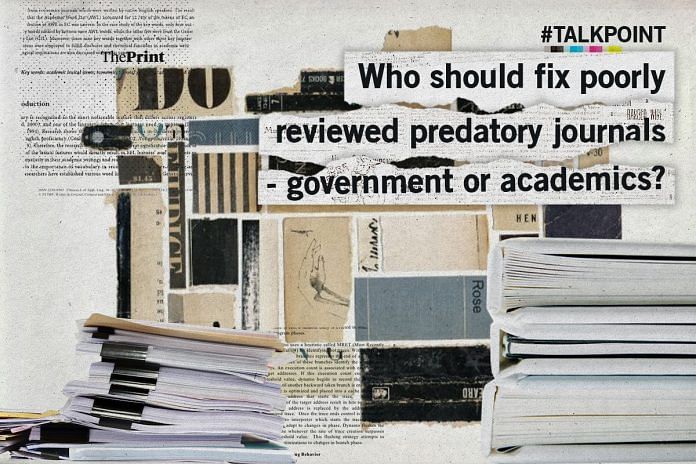Predatory journals are dubious research journals that charge authors money to quickly publish their studies and research, without conducting peer review and fact-check.
The University Grants Commission (UGC) approved 32,659 journals in June 2017, including many ‘predatory journals’. UGC has had to regularly drop such journals and update its whitelist, even as recently as earlier this month.
ThePrint asks: Who should fix poorly reviewed predatory journals – government or academics?
Regulatory bodies like UGC and AICTE are responsible for ensuring quality control
 Sukhadeo Thorat
Sukhadeo Thorat
Former chairman, University Grants Commission (UGC)
There are preconditions for giving a government project, and the main one is publication of articles in research journals. For career advancement in academics, a professor requires publication of his/her articles. As a result, the number of journals accepting publications rapidly increased in India around the year 2007.
Publication of articles has become a benchmark for academic achievements. Every so often, the University Grants Commission (UGC) publishes a list of approved journals. Recently, the body released a thousand or so names of journals from which they approve publications. These are recognised based on peer reviews. So, UGC has already taken a step to control the quality of these journals. There is already a process to monitor and standardise these journals. It is the UGC’s responsibility to follow these processes in a correct manner.
Regulatory bodies like the UGC and the All India Council for Technical Education (AICTE) should be fully responsible for ensuring quality control and monitoring of academic journals. What articles are to be considered, what journals are to be considered, and how the information should be authenticated are a part of the procedure that is put in place by the UGC. UGC only should refine the process.
PhD theses can be bought in India; predatory journals are the next step
 Abhijeet Borkar
Abhijeet Borkar
Postdoctoral researcher, Astronomical Institute of the Czech Academy of Sciences
The problem of predatory journals is multi-layered and will require effort from all sides to resolve the issue. It is important to target the root causes of their existence, and not simply treat the symptoms with black/whitelists.
Predatory journals have risen and thrived in an ecosystem where there is high competition among researchers to get several articles published to strengthen their resume to increase their chance in securing jobs and grant applications.
Although the trend of predatory journals may have started with tricking academics into submitting articles to substandard publications, but today it has evolved into a symbiotic relationship. When funding is deficient and the research lacks quality, researchers may turn to predatory journals to get something published.
In India, where cheating in exams is rampant at all levels of education and PhD theses can be bought, predatory and fake journals are just another step in an academic struggle to get maximum numbers by any means possible. Thus multifaceted, long-term solutions and extensive efforts are necessary to address these issues. Grants’ agencies should strive to create better metrics for judging research output and performances to overcome the ‘publish or perish’ cycle that facilitates predatory journals.
In long-term, institutions should invest in training students, and aspiring researchers must understand the publishing process so that they don’t inadvertently fall prey to predatory practices. An effort has to be made to also instil ethics among the authors from early on, and there should be repercussions for participating in predatory journals.
Bring focus back on quality of academic research rather than numbers
 Dibyendu Nandi
Dibyendu Nandi
Astrophysicist at IISER Kolkata, and leads Center of Excellence in Space Sciences India
Predatory journals are here to stay until the root cause of their existence is addressed. Their existence has been fuelled by an increasing reliance on assessing research output by the sum total rather than the quality of individual publications. This is not a phenomenon limited to India, but is a problem globally, and can be attributed to the rapid growth in the number of institutions, scientists, and students in the higher education system, especially in developing nations. This is a problem of numbers gaining more emphasis over quality.
Handling larger human resource and funding requests necessitate that science administrators and funding agencies make quick decisions on career advancements and funding of research projects from an increasingly large pool; a decision that is relatively easy to achieve based on numbers. While most of us see this as a problem, wily publication houses see this as an opportunity by providing an easy outlet for fattening the publication portfolio of gullible academicians.
Government funding agencies and academics need to develop mutual trust and work together to solve this problem. Both must realise that there is no easy, quick fix, such as publishing an ad-hoc list of predatory journals or declaring that all paid journals are predatory. Every other day a new predatory journal crops up and many reputed journals actually rely on page charges, making these ad-hoc fixes untenable.
I believe the solution for this problem lies in bringing the focus back on quality of academic research and developmental activities rather than numbers. While government agencies must engage with academicians and rely upon them to provide the critical peer review that enables a judgement on quality amid this noise of numbers, academicians must step up and assist in self-correcting this academic ecosystem.
Key problem with research in India is low trust in the system
 Pavan Srinath
Pavan Srinath
Fellow and faculty member at Takshashila Institution
By and large, this should ideally be a self-regulation issue for institutions employing researchers. Individual universities should be held accountable to the government as government funds flow into these systems. But the key problem with research in India is that there is extremely low trust in the system. Whatever solutions people come up with are operating in this environment. So, requirements will always be flouted, one way or the other. The government should think about the kind of proposals and academic policies it can come up with to improve trust in the system.
Metrics based on just numbers lead to predatory systems and good science suffers. We see this everywhere. When conferences are organised in institutions, students collect participation certificates and leave, and institutions then announce that 2,000 students participated. Predatory journals are in a system like this wherein people run around in hoops, taking advantage to achieve targets.
Government is the one that is setting rules here, so it can play a financing or facilitating hand in mitigating this problem. Government-funding agencies can also promote the use of Arxiv/SSRN – a step that can throw more light on the research. Plagiarism can be better deterred through openness, and plagiarism/fraud is a problem that mirrors predatory journals.
Academic policies allowing institutions to set their own mandate instead of publishing in journals with a certain minimum impact factor may go a long way in checking the trend of predatory journals. The total number of citations reflect quality much better than the impact factor, which can vary drastically across fields. Unfair measure of metrics is more likely to happen when standardisation across fields is centralised the way it is today.
Even UGC’s curated list is teeming with predatory journals
 Subhra Priyadarshini
Subhra Priyadarshini
Editor, Nature India
For a while now, India has topped the list of countries that submit papers to predatory journals. Fake journals and conferences that publish sham proceedings thrive in our country purely due to their huge demand. This demand stems from the need for PhD scholars to mandatorily publish in order to get their doctoral degrees.
For scientists and researchers, getting grants, promotions and climbing the career ladder are directly proportional to the number of papers they publish. This ‘publish or perish’ regime comes with no inherent standardisation. This means that there’s no fool-proof checklist or set or rules for researchers to choose the right journals to publish in. The UGC, India’s apex body responsible for maintaining standards of higher education, curates a list teeming with predatory journals and keeps culling dubious journals from the list now and then.
The government could help stop proliferation of these fake journals by deep-cleaning and rigorously maintaining this UGC list. It should also introduce ethical publishing training as part of doctoral research. Furthermore, the government could introduce tangible and measurable alternatives to publishing, such as ‘social impact of research’, as a yardstick to measure success.
Academic institutions should figure out incentives apart from just publication
Government must standardise quality and ensure structural reforms
 Anand Philip
Anand Philip
Works in health technology and primary care
Open access is the way to go here because the biggest problem we face is lack of transparency in data. Data needs to be shared with everyone as much as possible and be open to scrutiny. The government’s role should be to standardise quality, especially in government-funded studies, and enable structural reforms.
However, an important way to fix this would be to have funding agencies start fixing a publication fee as a part of the grants they give out. Currently, a major problem with publishing in open access journals like Public Library of Science (PLOS) is the cost, which can be as much as $3,000. Researchers can either pay from of their own pocket or no go through the due processes.
Here’s where predatory journals come into the picture. A main enabler for them to thrive is the low cost of publication, which can’t be matched by a standard journal because editing and reviewing is an expensive process. Publication should require a dedicated breakdown of funds, including publishing fees.
Academic institutions should also figure out incentives apart from just publications. Status quo mandates publishing and therefore researchers go after numbers. Incentives for publishing replication studies that validate previous ones or publishing new results in Indian journals or journals affiliated with valid associations will help the process tremendously.
Predatory journals poach on journals run by Indian associations because the latter are not always well-managed or funded. But, prioritisation of Indian journals by Indian scientific bodies will automatically keep the academic quality in check. This can only be done by academic organisations.
Scientists often know the predatory journals to stay away from, they should make lists
 Sandhya Ramesh
Sandhya Ramesh
Sr. Asst Editor, Science
Predatory journals have thrived in a system aided and abetted by our government, albeit inadvertently. The regulatory body has attempted standardising journal qualities and review, but we can see that despite their efforts, several predatory journals still tend to creep into their lists of approved journals. Furthermore, the process to get them removed or submit a complaint is tedious and cumbersome.
Ideally, regulatory bodies should be prompt and on top of things at all times. Government agencies like the Department of Biotechnology (DBT) or Defence Research and Development Organisation (DRDO) shouldn’t offer grants on the basis of papers published in dubious journals without proper peer review. Unfortunately, in today’s age of rampant misinformation and extreme connectivity, it is imperative to prevent publication and legitimisation of wrongful and harmful data. Or, at least, call it out. While we wait for the government and regulatory bodies to do their due, we can also take some small steps ourselves.
Scientists, editors, and science communicators are often aware of several predatory journals, which are the root to a lot of sources cited in online misinformation. Scientists, especially those who publish regularly, often know the kind of publications to stay away from. Lists can be made to rank these publications and create general awareness about predatory journals in an effort to aid researchers looking to publish.
There have been several proposals for the kind of metrics to follow, such as Beall’s criteria and the rankings built on top of them, like the Dadkhah’s ranking system, which could be a good place to start amplifying and calling such journals out.
Compiled by Sandhya Ramesh




The better way to check the problems relating to the predatory journals is that those journal which charge a high publication fee will not be considered.The government or UGC should decide a maximum publication charge which will check those agencies that are profit seeking..Actually they are root cause of predatory journal.
Commercialisation of publication should be checked otherwise we could not retain proliferation of quality of journals.